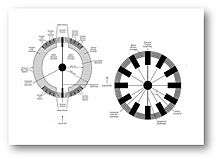Respirocyte
Respirocytes are hypothetical, microscopic, artificial red blood cells that are intended to emulate the function of their organic counterparts, so as to supplement or replace the function of much of the human body's normal respiratory system. Respirocytes were proposed by Robert A. Freitas Jr in his 1998 paper "A Mechanical Artificial Red Blood Cell: Exploratory Design in Medical Nanotechnology".[1]
Respirocytes are an example of molecular nanotechnology, a field of technology still in the very earliest, purely hypothetical phase of development. Current technology is not sufficient to build a respirocyte due to considerations of power, atomic-scale manipulation, immune reaction or toxicity, computation and communication.
Structure of a respirocyte
Freitas proposed a spherical robot made up of 18 billion atoms arranged as a tiny pressure tank, which would be filled up with oxygen and carbon dioxide.[2]

Uses
In Freitas' proposal, each respirocyte could store and transport 236 times more oxygen than a natural red blood cell, and could release it in a more controlled manner.
Such respirocytes would allow an adult human to sprint at top speed for at least 15 minutes without taking a breath.[3]
Muscle fatigue results from inadequate supply of oxygen to the muscles during intense exercise, leading to inefficient lactic acid fermentation. If respirocytes could increase the supply of oxygen despite exercise, it should be possible to reduce muscle fatigue, increasing a person's endurance.
Freitas has also proposed "microbivore" robots that would attack pathogens in the manner of white blood cells.[4]
References
- ↑ Robert A. Freitas Jr. (1998). "Exploratory Design in Medical Nanotechnology: A Mechanical Artificial Red Cell". Artificial Cells, Blood Substitutes, and Immobil. Biotech. (26): 411–430.
- ↑ "RESPIROCYTES – IMPROVING UPON NATURE'S DESIGN: BREATHE EASY WITH RESPIROCYTES".
- ↑ CNN – Scientists: Humans and machines will merge in future
- ↑ Kurzweil, Ray. The Singularity Is Near. p. 254.
External links
- What are Respirocytes? at nsta.org
- Respirocytes at foresight.org
- Emerging trends of nanomedicine – an overview – Respirocytes
- Animation of a respirocyte (an artificial red blood cell) being injected into the bloodstream